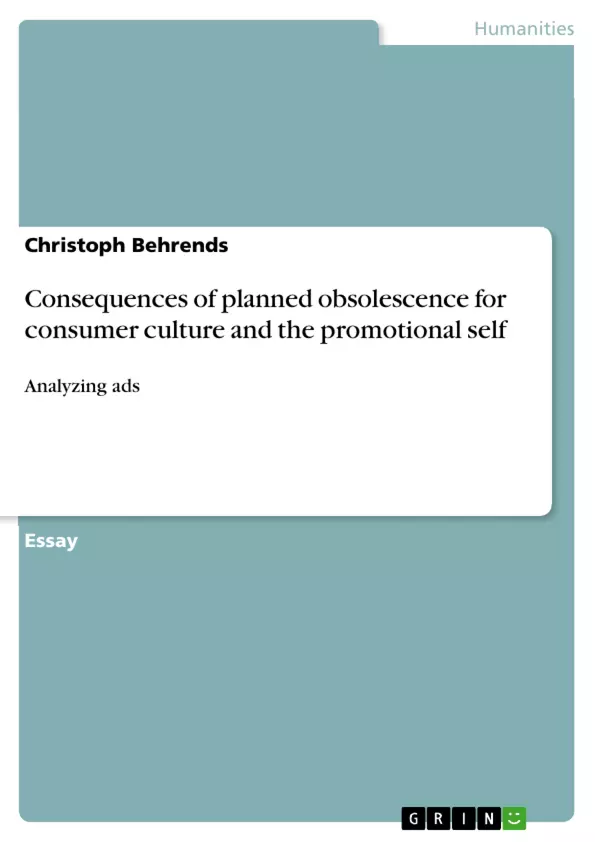During the 20th century, the industrialised countries have developed an extensive amount of obsolescence. It has become clear that nations in the developed world over-consume, while the poor in the developing world pay the price of our increased consumption with their lowered standards of living and increasing environmental damage .
When did obsolescence emerge, in how far is it planned, and which consequences does it have for consumer culture and the promotional self on a broader scale? By drawing on numerous examples, this essay explains how advertisements are constructed semiotically and the ideologies they derive from.
Table of Contents
- Introduction
- Consumer Culture
- The History of Consumer Culture
- The Role of Advertising in a capitalist Consumer Culture
- Consequences of planned Obsolescence
- Advertising creates new Needs constantly
- Advertisements praise the New to be better than the Old
- Convincing consumers of the indispensable Possession of a Product
- Products and images
- Strategies to deal with obsolescence
- Conclusion
Objectives and Key Themes
This essay explores the emergence of planned obsolescence and its impact on consumer culture and the promotional self. It investigates how planned obsolescence has shaped consumer behavior and the role of advertising in perpetuating this cycle.
- The historical evolution of consumer culture and planned obsolescence
- The role of advertising in creating and manipulating consumer needs
- The strategies used by advertisers to convince consumers of the need for new products
- The impact of planned obsolescence on consumer identity and self-perception
- The potential consequences of planned obsolescence for society and the environment
Chapter Summaries
- Introduction: This chapter introduces the concept of planned obsolescence, highlighting its prevalence in developed countries and its negative consequences for the developing world. It uses the example of the DVD industry to illustrate how planned obsolescence works.
- Consumer Culture: This chapter explores the historical development of consumer culture, focusing on the shift from agricultural and artisanal production to industrial mass production. It outlines the key features of consumer culture and its relationship to obsolescence, emphasizing the role of advertising in creating demand.
- The History of Consumer Culture: This chapter delves deeper into the historical roots of consumer culture, tracing its origins to the 18th century and its subsequent evolution in the 20th century. It discusses the impact of industrialization and the rise of mass marketing on consumer behavior.
- The Role of Advertising in a capitalist Consumer Culture: This chapter examines the role of advertising in perpetuating consumerism and planned obsolescence. It discusses how advertising creates artificial needs and manipulates consumer desires, ultimately contributing to feelings of dissatisfaction and a constant drive for new products.
- Consequences of planned Obsolescence: This chapter explores the specific consequences of planned obsolescence for consumer culture and the promotional self. It examines how advertising strategies, such as creating new needs, praising the new over the old, and convincing consumers of the indispensability of products, contribute to a cycle of consumption and dissatisfaction.
Keywords
The primary focus of this essay is on the concept of planned obsolescence, its historical development, and its impact on consumer culture. Key terms and concepts include advertising, consumer behavior, product design, consumerism, social attitudes, and identity construction. The essay also touches upon the broader themes of industrialization, capitalism, and environmental sustainability.
- Quote paper
- Christoph Behrends (Author), 2004, Consequences of planned obsolescence for consumer culture and the promotional self, Munich, GRIN Verlag, https://www.grin.com/document/82675



